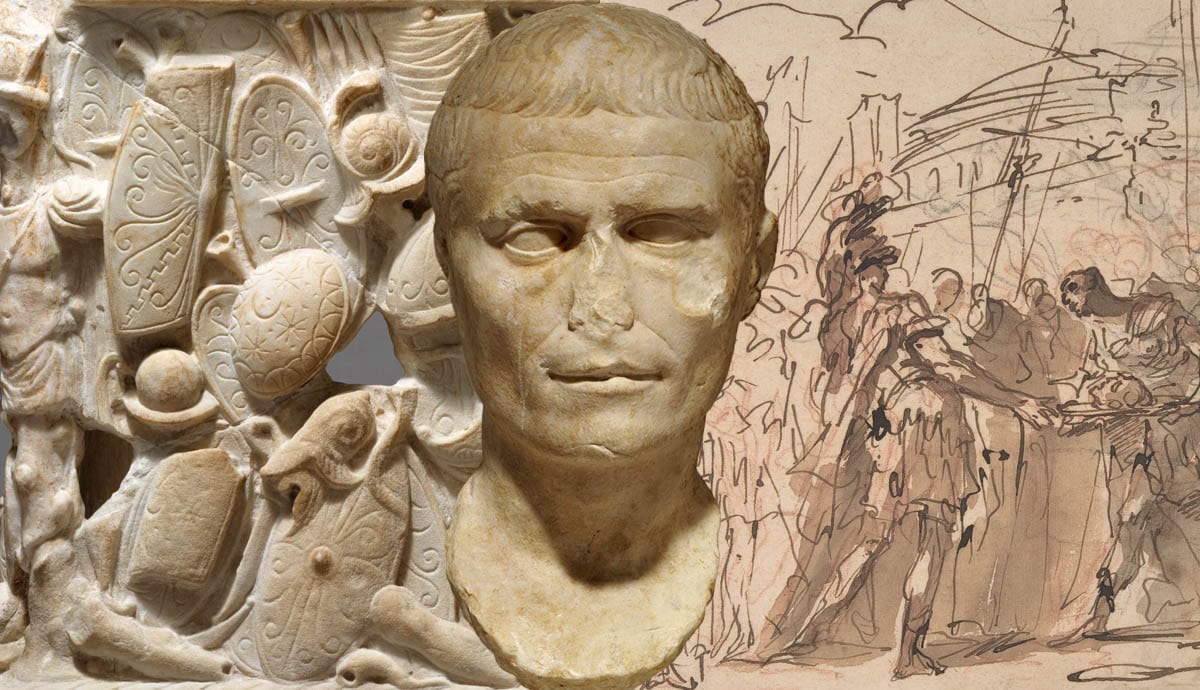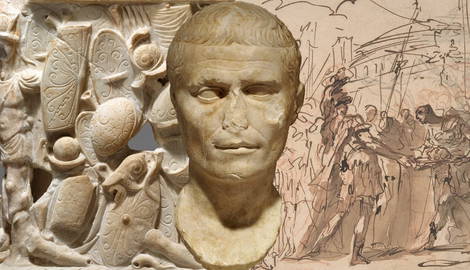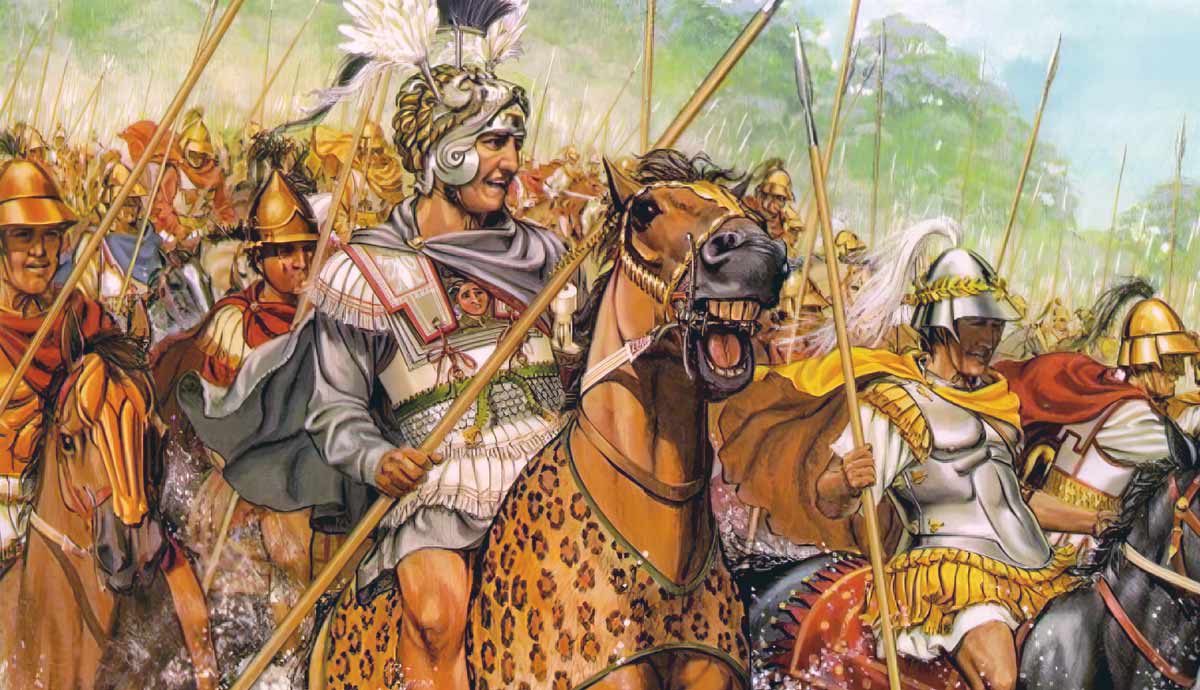
Following his defeat at the Battle of Pharsalus (48 BC) in Northern Greece, Julius Caesar’s opponent Pompey fled to Egypt where he hoped to find safety and support. Pompey was well regarded in the Eastern Mediterranean where he had befriended many local rulers. His arrival in Egypt, however, came at a time when the ruling Ptolemaic Dynasty was embroiled in its own civil war between the forces of the young King Ptolemy XII Auletes and his sister Cleopatra. Fearful that Pompey might suborn the Ptolemaic army and hoping to win Caesar’s support, Ptolemy’s regents, the eunuch Pothinus and the generals Achillas and Sempronius, seized Pompey and put him to death. Having pursued Pompey ever since the Battle of Pharsalus, Caesar himself arrived a few days after the execution. These events would lead to the Alexandrine War in 48-47 BC.
Julius Caesar In The City Of Alexander

At this time, Alexandria was nearly 300 years old having been founded by Alexander the Great during his time in Egypt. It was located on the Canopic branch of the Nile on the western extreme of the delta. Alexandria sat on an isthmus, separating the Mediterranean Sea and lake Mareotis. Off the Mediterranean coast lay the island of Pharos, an oblong island that ran parallel to the shore and formed a natural harbor with two entrances. Since Alexander’s time, the city of Alexandria had grown into the largest city of the Mediterranean world and was considered the jewel of Ptolemaic Egypt.
Julius Caesar’s arrival in the Ptolemaic capital was neither pleasant nor tactful as he managed to offend his host from the moment he stepped off the ship. While disembarking Caesar had the fasces or standards carried before him, which was viewed as a slight to the royal dignity of the king. While this was smoothed over, clashes between Caesar’s men and the Alexandrians occurred throughout the city. Caesar then exacerbated the situation by ordering Ptolemy and Cleopatra to disband their armies and submit their quarrel to him for judgment. He also demanded immediate repayment of a massive loan he had made to the Ptolemies several years earlier. Fearing a loss of their power, Pothinus and Achillas began to plot against Caesar and the Romans.
The Opposing Forces

As a result of the ongoing Roman Civil War, Julius Caesar only had a few troops available when he came to Alexandria. He arrived with a small fleet of 10 warships from his Rhodian allies and a small number of transports. The rest of the Roman and allied fleets had been loyal to Pompey and in the aftermath of Pharsalus could not be trusted. Caesar also had with him the severely understrength 6th and 28th legions. At a time when a legion consisted of 6,000 men, the 6th numbered only 1,000 and had previously served under Pompey while the 28th had 2,200 men who were mostly new recruits. Caesar’s best troops were a body of 800 Gauls and Germans equipped as Roman cavalrymen.
The Alexandrian forces were far more impressive. Alexandria had a permanent fleet of 22 warships stationed in the harbor which was reinforced by 50 ships which had been sent to aid Pompey. Pothinus and Achillas also had command of the Ptolemaic Royal Army which consisted of 20,000 infantrymen and 2,000 cavalrymen. Surprisingly perhaps, the best troops at their disposal were not Ptolemaic but Roman. A force of 2,500 Roman legionaries and auxiliaries stationed in Egypt many years earlier decided to side with the Egyptians. To these regular forces can also be added the citizens of Alexandria who were willing to fight for their homes.
Achillas & Alexandrians Attack

The approach of the Ptolemaic forces was noticed by Julius Caesar and the Romans, but they were too few to man the walls of Alexandria. Soon the only part of Alexandria still occupied by the Romans was the palace district. At least partially surrounded by a wall, the palace district was located on Cape Lochias which sat on the eastern end of Alexandria’s Great Harbor. Besides the palace and government buildings, the palace district also included the Sema, the burial site of Alexander and the Ptolemaic kings, the Great Library, the Museum or Mouseion, and its own dockyard known as the Royal Harbor.
While the Romans were not numerous enough to defend the walls, Julius Caesar had posted several cohorts throughout the city to slow the advance of the Ptolemaic forces. The fiercest fighting of the Siege of Alexandria occurred along the docks of the Great Harbor. When the fighting began most of the Ptolemaic warships had been hauled out of the water, as it was winter and they were in need of repairs. With their crews dispersed throughout the city, it was impossible to quickly relaunch them. As a result, the Romans were able to burn most of the ships in the Great Harbor before retreating. While this was going on Caesar also sent men across the har to seize the lighthouse on the island of Pharos. This gave the Romans control of the entrance to the Great Harbor and a vantage point from which they could observe the Ptolemaic forces.
The Siege Of Alexandria: The City Becomes A Warzone

As night fell after the first day of fighting both the Roman and Ptolemaic forces strengthened their siege lines. The Romans sought to fortify their position by demolishing nearby buildings Ptolemaic troops could use, building walls, and securing access to food and water. Ptolemaic forces sought to clear avenues of attack, build walls to isolate the Romans, build siege machines, and gather more troops.
While this was going on Pothinus, who had remained in the Palace District, was caught communicating with the Ptolemaic army and was executed. Following his execution, Arsinoe, a younger daughter of the previous Ptolemaic king escaped from the palace district and after having Achillas put to death, assumed control of the Ptolemaic Army. Unable to lead on her own, Arsinoe placed her former tutor the eunuch Ganymede in command. Ganymede reorganized the Ptolemaic forces and sought to cut the Romans’ water supply. Alexandria got its water from the Canal of Alexandria, which ran the length of the city from the Canopic Nile to the Western or Eunostos harbor. Smaller canals branched off to bring water throughout the city.
Mare Nostrum

Ganymede’s strategy put the Romans in dire straits and Julius Caesar was forced to halt all operations for several days until new wells could be dug. Shortly thereafter, a Roman supply fleet arrived but was unable to enter the harbor due to the Easterly winds without help. Concerned about the growing Roman naval strength the Ptolemaic army fortified the section of the harbors they controlled, built new warships, and sent out messages to gather every available warship in Egypt. After landing his supplies, Caesar sent his ships around the island of Pharos to the entrance of the Eunostos harbor. The island of Pharos was connected to the mainland by a mole known as the Heptastadion. It was the Heptastadion that divided the Great and Eunostos harbors; though it was possible to sail under the Heptastadion in some places.
The new Ptolemaic fleet sailed out to engage the Romans but was defeated. However, the Ptolemaic fleet was not destroyed since its retreat was covered by Ptolemaic forces on land. In response, Julius Caesar decided to capture the island of Pharos. While the Romans had occupied the lighthouse early on, the rest of the island and its small community remained in Ptolemaic hands. Ptolemaic forces attempted to prevent the Roman landings but were unsuccessful and were forced to retreat back into Alexandria.
Caesar Takes A Swim

After fortifying the Roman position on Pharos, Julius Caesar decided to seize control of the Heptastadion in order to deny Ptolemaic access to the Eunostos Harbor. The Heptastadion was seven stadia or .75 miles long. At either end of the mole, there was a bridge under which ships could pass. The Heptastadion was the last position Caesar needed to seize in order to control Alexandria’s harbor. The Romans took control of the bridge closest to Pharos when they occupied the island, so now they moved against the second bridge. The few Ptolemaic soldiers were chased away by the Roman ships and soldiers. However, a larger number of Ptolemaic soldiers soon gathered and launched a counterattack. The Romans soldiers and sailors panicked and tried to escape. Caesar’s ship became overcrowded and began to sink.
Throwing off his purple cloak, Caesar leaped into the harbor and attempted to swim to safety. While Caesar escaped the Ptolemaic soldiers carried off his cloak as a trophy and celebrated their victory. The Romans lost somewhere around 800 soldiers and sailors in the fighting and Ptolemaic forces were able to reoccupy the bridge. Shortly after this, the Siege of Alexandria settled into a stalemate, though the Romans held the advantage in the daily fighting.
Death On The Nile: Julius Caesar’s Victory

With the siege now stalemated the Ptolemaic forces requested that Julius Caesar release Ptolemy XIII Auletes, who had been in Caesar’s custody the entire time. There was, it seems, widespread discontent with the leadership of Arsinoe and Ganymede. Hoping to bring the war to a conclusion, Caesar complied but was disappointed when Ptolemy merely continued the conflict after his release. Eventually, Caesar received word that Mithridates of Pergamum and Antipater of Judea, trusted Roman allies hoping to show their support of Caesar, was approaching with a large army. Caesar sailed out from Alexandria to meet up with the relief force with the Ptolemaic Royal Army also moved to intercept.
The two armies clashed in what became known as the Battle of the Nile 47 BC. Ptolemy XIII drowned after his ship capsized during the battle and the Ptolemaic army was crushed. Immediately after the battle Julius Caesar set off with the cavalry and rode back to Alexandria where many of his men were still under siege. As word of the victory spread, the remaining Ptolemaic forces surrendered. The 12-year-old Ptolemy XIV became co-ruler with Cleopatra, who held all the real power and was now a committed ally of Caesar. Ganymede was executed and Arsinoe was exiled to the Temple of Artemis in Ephesus, where she was later executed on the orders of Mark Antony and Cleopatra. With Pompey dead and Egypt now secure, Caesar spent several months touring Egypt with Cleopatra before continuing on with the Great Roman Civil War.










